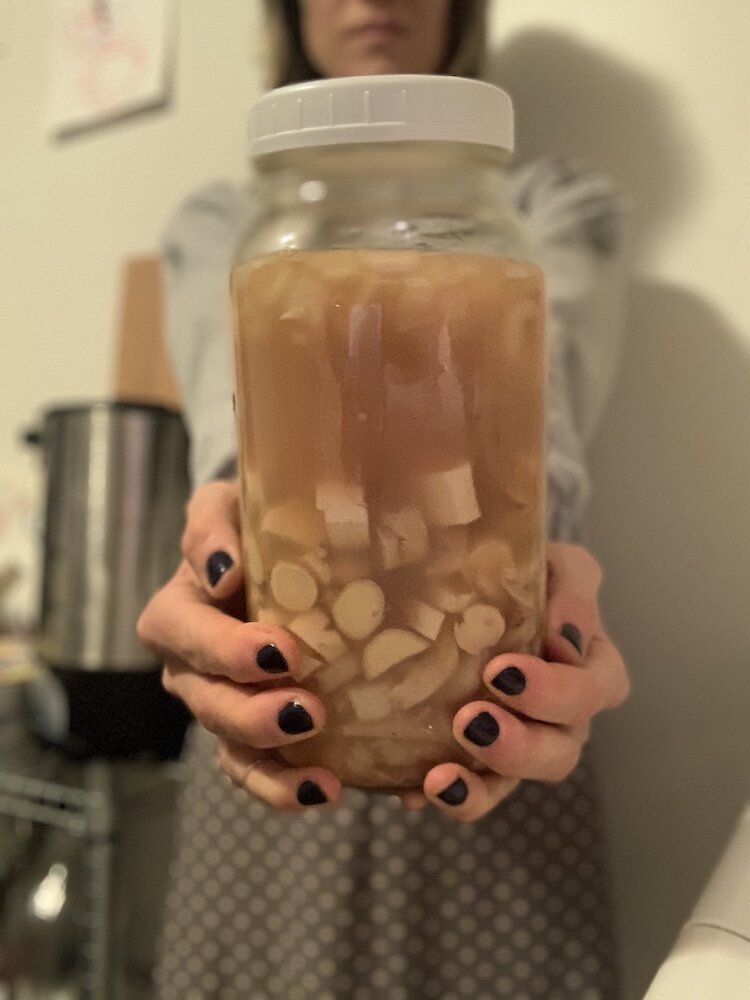Bringing on the New Year's HOT...with Fire Cider
The time between winter solstice and the new year is one for reflection and setting intentions. We are nature, not separate from it and just as nature retreats inward, so do we; cultivating and planning for the up and outwards energies of spring. To ritualize this time and play with the magic of plants, I recently made a Fire Cider. Inspired by a gift of fire cider by Shire City Herbals from my aunt, I have been taking daily shots to support my health. This week I share with you what fire cider is, how to make this immune supporting tonic and highlight some science backing it all up.
Fire cider is a home-remedy made from things you probably have in your kitchen. It’s a culmination of plants and vinegar formulated for health and vitality. It’s hot and warming, perfect for these dark and winter months. There are many ways to make this recipe your own. My recipe is inspired by Rosemary Glandstar (link to a youtube tutorial). Equal parts: horseradish root, ginger root, onion, garlic, ¼ tsp of cayenne pepper, and covered with an organic apple cider vinegar (ACV) like Bragg’s. I used 200 grams of horseradish root, ginger, and onion, and one head of garlic. Peel and chop the horseradish root into 1” cubes, wash and chop the ginger into 1” cubes, crush and peel the garlic, and chop the onion. Place all contents, including the cayenne pepper into a half gallon mason jar and completely cover with ACV. Add parchment paper between jar and lid to prevent lid rusting (if using a metal lid). Place in a sunny window for 3-4 weeks, shaking the contents frequently. After the 3-4 weeks, strain out the herbs and enjoy. This can be taken as a shot, mixed with juices/tea/cocktails, or used in salad dressings.
Horseradish root: traditionally used to treat bacterial infections of the respiratory tract and urinary bladder, this root has been shown to exert anti inflammatory actions on human cells (1). In respiratory infections, we know that the bugs induce and perpetuate inflammation of the tissue which can lead to damage (2).
Ginger root: has been used culinarily and medicinally for centuries. The health promoting effects come from ginger’s rich constitution of plant chemicals that can exert physiology responses in the human (3). These chemicals are associated with increased antioxidants, enhanced immunity, and reduced inflammation (4).
Onion and Garlic: from the same family, these plant foods enhance immune function in animals (5) and help fight off bugs that cause infection (6). In fact, garlic may be considered a broad-spectrum antimicrobial (7) and has been called the ‘poor mans’ penicillin.’ It also may enhance efficacy of antibiotics when taken together (8).
Cayenne Pepper: contains the plant chemical capsaicin which has anticancer, anti inflammatory, and pain relieving effects (9). This adds a warmth to the tonic that’s perfect for the winter.
ACV: vinegar itself can help fight bugs (10) and its acidic nature draws out the medicine.
Here’s to a new year of health, happiness, and love.
Resources
https://www.ncbi.nlm.nih.gov/pmc/articles/PMC5274677/
https://www.ncbi.nlm.nih.gov/pmc/articles/PMC3665023/
https://pubmed.ncbi.nlm.nih.gov/6366484/
https://www.ncbi.nlm.nih.gov/pmc/articles/PMC5788933/


